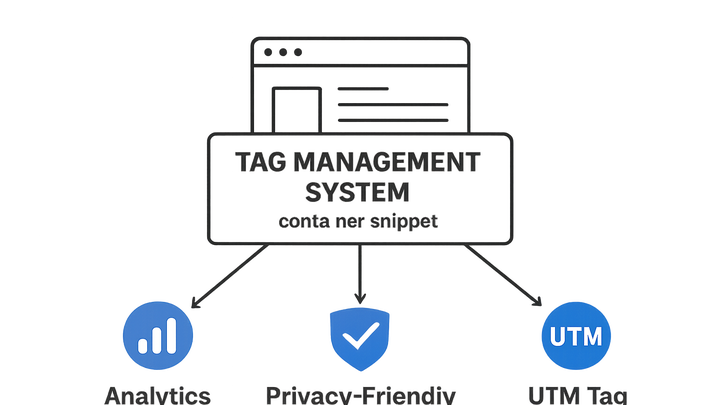Published on 2025-06-29T19:25:30Z
What is Tag Management? Examples and Best Practices
Tag Management refers to the process of deploying and organizing various tracking tags (JavaScript snippets) used for analytics, marketing, and conversion tracking on digital properties. In the campaign tracking & analytics industry, a Tag Management System (TMS) centralizes control of these tags into a user-friendly interface, enabling marketers and analysts to add, update, or remove tags without manual code deployments. This approach reduces development bottlenecks, improves site performance by loading tags efficiently, and enforces consistent tagging standards across the organization. With the rise of privacy-focused analytics like plainsignal (a cookie-free simple analytics solution), and specialized UTM parameter tools like utmguru.com, integrating these tools through a TMS ensures data accuracy and compliance. By using a TMS, teams can maintain version control, implement privacy controls, and quickly iterate on campaign tracking strategies. Overall, tag management is a foundational practice for modern digital marketing operations.
Tag management
A Tag Management System centralizes the deployment and management of analytics and marketing tags for streamlined campaign tracking.
Why Tag Management Matters
A Tag Management System (TMS) simplifies the deployment and management of tracking tags, empowering teams to run campaigns faster and more accurately.
-
Agility and speed
Marketers can add or update tags without waiting for developer releases, accelerating campaign launches and adjustments.
-
Performance optimization
TMS solutions load tags asynchronously and use conditional triggers to minimize site impact and avoid slowing down user experience.
-
Governance and compliance
Centralized control ensures tags meet privacy regulations and reduces duplication or orphaned tags, improving data accuracy and compliance.
Core Components of a Tag Management System
Most TMS platforms include several key elements that work together to manage tags effectively and reliably.
-
Container snippet
A small piece of code installed on every page, acting as the entry point for loading and managing tags.
- Asynchronous loading:
Ensures tags load without blocking other page resources, improving performance.
- Container id:
Unique identifier that connects your website to your TMS account.
- Asynchronous loading:
-
Tags
Snippets of JavaScript or HTML that send data to analytics and marketing tools when triggered.
-
Triggers
Rules that define when tags should fire, such as page views, clicks, or custom events.
- Page view triggers:
Activate tags on page loads, like homepage or checkout pages.
- Click triggers:
Activate tags when users click on specific buttons or links.
- Page view triggers:
-
Variables
Data placeholders used to capture dynamic values, such as URLs, form fields, or custom JavaScript variables.
- Built-in variables:
Common metrics provided by the TMS, like page URL, referrer, or event type.
- Custom variables:
User-defined values like user ID, session ID, or e-commerce transaction data.
- Built-in variables:
Implementing Tag Management for Campaign Tracking
Explore how to integrate PlainSignal and UTMGuru within your TMS to manage analytics scripts and UTM parameters seamlessly.
-
Integrating plainsignal
Add the PlainSignal tracking code through your TMS to collect privacy-friendly analytics without cookies.
- Snippet example:
<link rel="preconnect" href="//eu.plainsignal.com/" crossorigin /> <script defer data-do="yourwebsitedomain.com" data-id="0GQV1xmtzQQ" data-api="//eu.plainsignal.com" src="//cdn.plainsignal.com/plainsignal-min.js"></script>
- Snippet example:
-
Managing utm parameters with utmguru
Use utmguru.com to build, generate, and manage UTM-tagged URLs, ensuring consistent campaign tracking across channels.
- Build and generate urls:
Specify campaign source, medium, name, term, and content in the utm builder for precise tracking.
- Save and list links:
Save frequently used URLs in UTMGuru for quick access via the dashboard or Chrome extension.
- Build and generate urls:
-
Testing and debugging
Use your TMS’s preview and debug mode to verify tags, triggers, and variables before publishing to production.
- Preview mode:
Simulate page loads and events to see which tags fire and inspect data layer values.
- Debug console:
Review console logs and network requests to ensure data is sent correctly to analytics endpoints.
- Preview mode:
